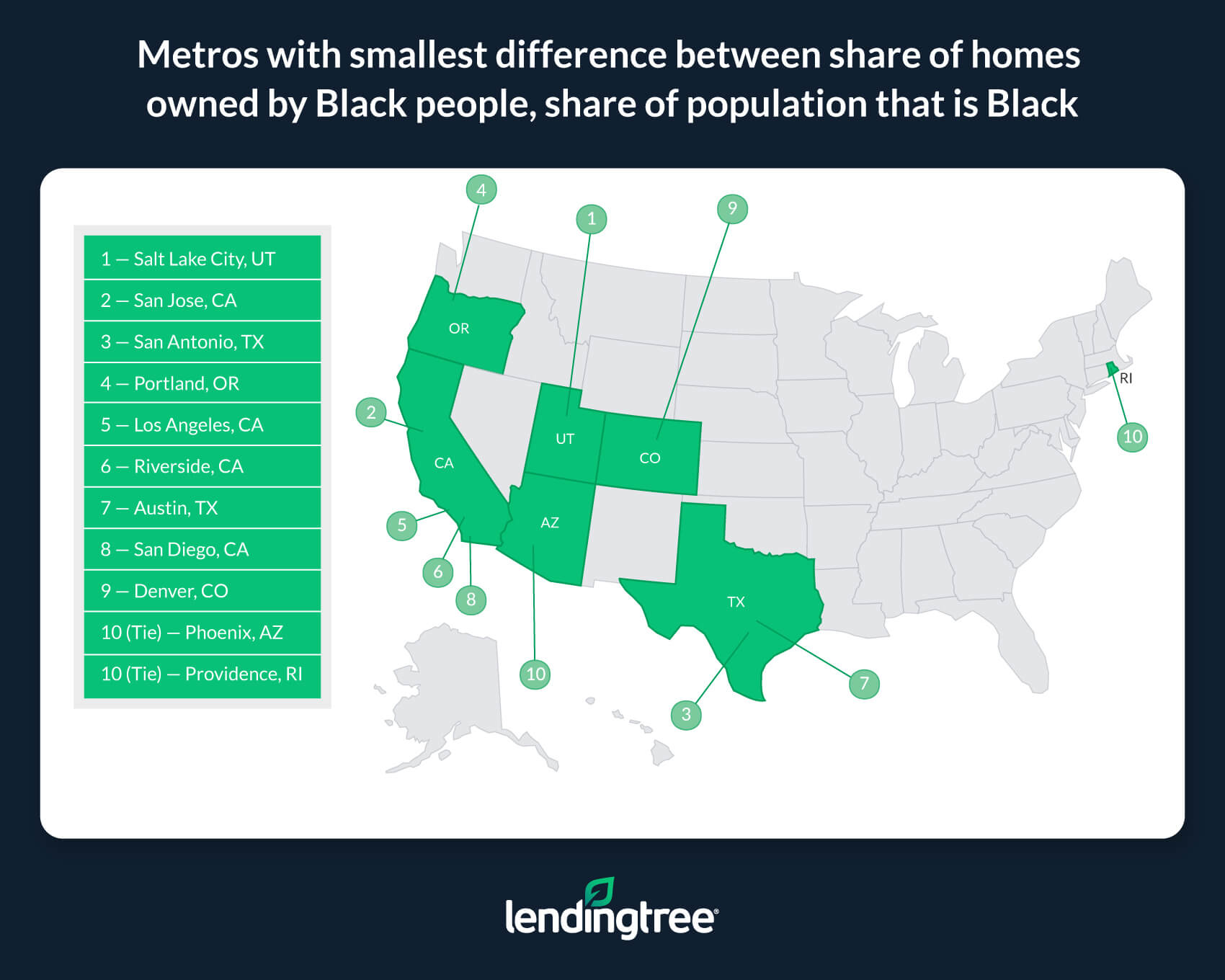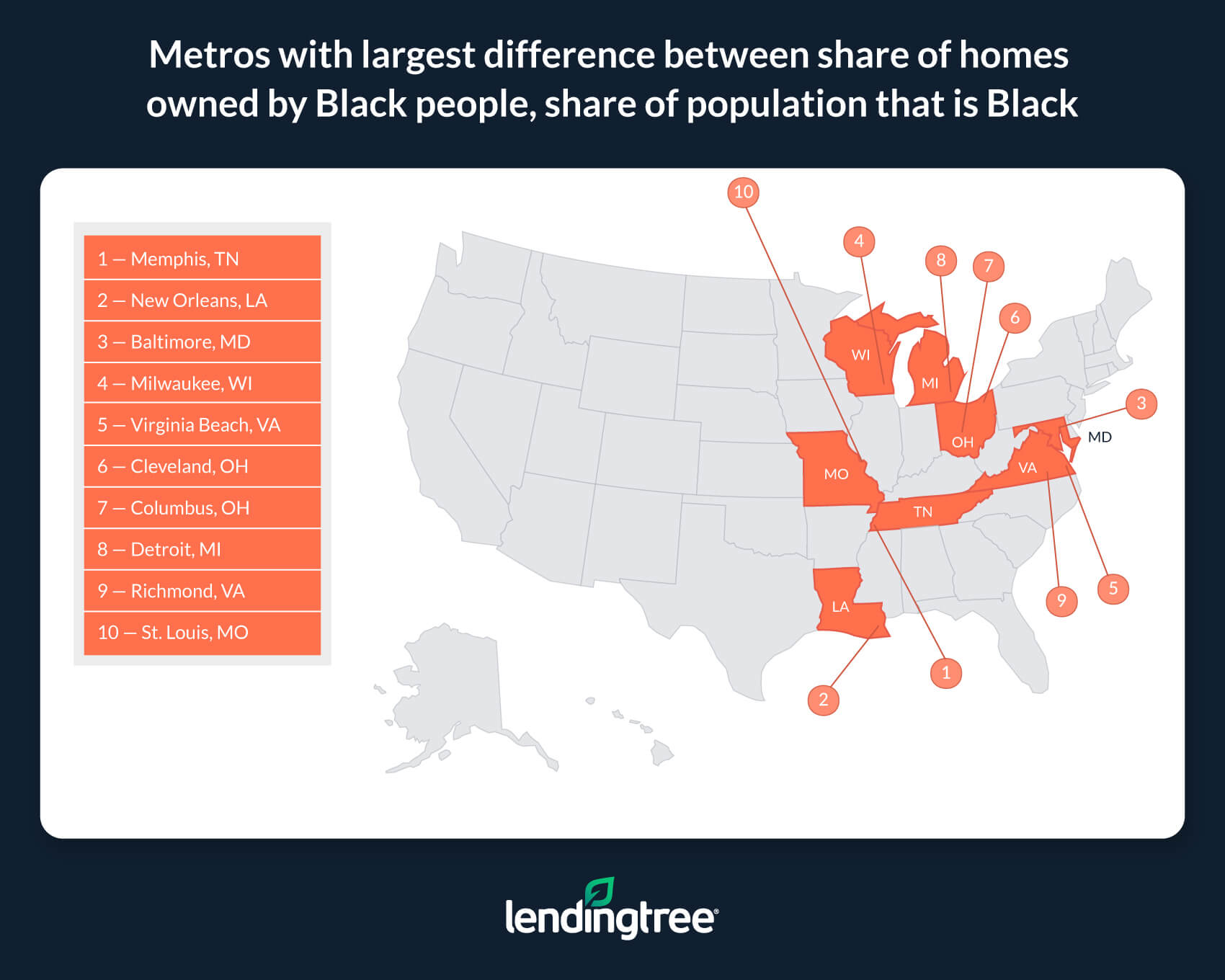Black People Own Disproportionately Small Share of Homes in 50 Largest US Metros
Racial inequality is a major issue in the U.S., with people of different races facing varying socioeconomic outcomes based on their heritage or skin color. This is especially true for Black Americans, among the most economically disadvantaged groups in the nation.
To highlight a key economic area in which Black Americans are often disadvantaged, LendingTree analyzed U.S. Census Bureau data on homeownership rates for Black people in the nation’s 50 largest metropolitan areas. Specifically, we compared the share of homes owned by those who identify as Black to the population of Black people living in each metro.
We found that Black Americans own a disproportionately small share of homes in each metro featured in our study.
On this page
- Key findings
- Metros with smallest differences between share of homes owned by Black people, share of population that is Black
- Metros with largest differences between share of homes owned by Black people, share of population that is Black
- What is driving this trend?
- Tips for Black homebuyers
- Methodology
Key findings
- In each of the nation’s 50 largest metros, Black people own a disproportionately small share of homes relative to population size. Black people make up an average of 14.88% of the population across the nation’s 50 largest metros, but they only own an average of 10.02% of owner-occupied homes across the same areas. For comparison, white people across the nation’s 50 largest metros account for an average of 58.21% of the population — yet they own an average of 70.51% of owner-occupied houses.
- Salt Lake City has the smallest difference between the share of homes owned by Black people and the share of the population that’s Black. In the metro, 1.68% of the population identifies as Black, while Black homeowners own 0.57% of owner-occupied housing units. That’s a difference of 1.11 percentage points. San Jose, Calif. and San Antonio have the next smallest differences at 1.22 and 1.27 percentage points.
- Memphis, Tenn., has the biggest difference between the share of homes owned by Black people and the share of the population that’s Black. In Memphis, Black people make up 46.70% of the population — the largest among any metro in our study. However, they own only 34.99% of occupied housing units in the metro, resulting in a disparity of 11.71 percentage points. Rounding out the bottom three are New Orleans and Baltimore, where the differences are 8.95 and 8.84 percentage points.
Metros with smallest differences between share of homes owned by Black people, share of population that is Black
No. 1: Salt Lake City
- Percentage of the population that is Black: 1.68%
- Percentage of owner-occupied housing units owned by Black people: 0.57%
- Difference: 1.11 percentage points
No. 2: San Jose, Calif.
- Percentage of the population that is Black: 2.37%
- Percentage of owner-occupied housing units owned by Black people: 1.15%
- Difference: 1.22 percentage points
No. 3: San Antonio
- Percentage of the population that is Black: 6.62%
- Percentage of owner-occupied housing units owned by Black people: 5.35%
- Difference: 1.27 percentage points

Metros with largest differences between share of homes owned by Black residents, population that identifies as Black
No. 1: Memphis, Tenn.
- Percentage of the population that is Black: 46.70%
- Percentage of owner-occupied housing units owned by Black people: 34.99%
- Difference: 11.71 percentage points
No. 2: New Orleans
- Percentage of the population that is Black: 33.37%
- Percentage of owner-occupied housing units owned by Black people: 24.42%
- Difference: 8.95 percentage points
No. 3: Baltimore
- Percentage of the population that is Black: 28.78%
- Percentage of owner-occupied housing units owned by Black people: 19.94%
- Difference: 8.84 percentage points

What is driving this trend?
As this study shows, Black people in each of the nation’s 50 largest metros own a disproportionately small share of homes relative to their population.
There are many potential reasons why. For example, according to the latest U.S. Census Bureau estimates, the median household income for those who identify as Black is $48,297. That’s almost $30,000 less than the $77,999 median income for white households.
Black Americans also:
- generally have less household wealth
- are more likely to be unbanked
- experience higher mortgage denial rates
Further, the legacies of historical policies meant to disenfranchise Black homebuyers, like “redlining,” have had a long-lasting impact that still contributes to the disproportionately low homeownership rates among Black people today.
That said, it’s important to note that while these examples can shed some light on why homeownership rates are relatively low for Black people, they’re not all the reasons why a person who identifies as Black may struggle to become a homeowner. And, ultimately, various socioeconomic factors continue to drive this unfortunate trend.
Tips for Black homebuyers
Despite this outlook, owning a home isn’t an impossible dream for all Black Americans. Here are three tips that could help make the homebuying process easier.
- Shop around for a mortgage. While mortgage rates have come down in recent months, they remain relatively high. But homeowners can still potentially secure a relatively low rate by shopping around for a mortgage. By comparing offers from different lenders, homebuyers may get a more competitive rate that makes buying more affordable.
- Know your rights. It’s illegal to deny someone a mortgage or refuse to sell them a house based on their race. If you believe that your rights have been violated during the homebuying process, you can file a complaint with the U.S. Department of Housing and Urban Development (HUD) or with various local housing and human rights commissions.
- Consider different types of mortgages. One of the reasons homeownership rates tend to be disproportionately low among Black homeowners is that Black households often earn smaller incomes. But there are many low-income mortgage loans for which Black homebuyers may qualify. By taking advantage of these types of loans, it‘s often easier to get approved for a mortgage and, as a result, buy a home.
Methodology
We analyzed the U.S. Census Bureau 2021 American Community Survey with one-year estimates (the latest survey available).
This study ranks the nation’s 50 largest metropolitan statistical areas (MSAs) by the difference between the percentage of owner-occupied homes in a metro owned by those who identify as Black (and no other race) and the percentage of an area’s population that identifies as Black (and no other race). The difference is displayed in percentage points.
The further this difference is from zero, the more disproportionate the number of Black homeowners in an area is. A positive difference would indicate that Black homeowners own a disproportionately large share of homes. In contrast, a negative difference indicates that Black homeowners own a disproportionately small percentage of homes.
